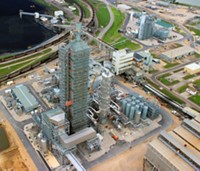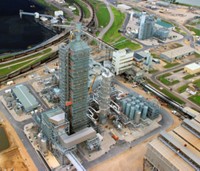Advertisement
Grab your lab coat. Let's get started
Welcome!
Welcome!
Create an account below to get 6 C&EN articles per month, receive newsletters and more - all free.
It seems this is your first time logging in online. Please enter the following information to continue.
As an ACS member you automatically get access to this site. All we need is few more details to create your reading experience.
Not you? Sign in with a different account.
Not you? Sign in with a different account.
ERROR 1
ERROR 1
ERROR 2
ERROR 2
ERROR 2
ERROR 2
ERROR 2
Password and Confirm password must match.
If you have an ACS member number, please enter it here so we can link this account to your membership. (optional)
ERROR 2
ACS values your privacy. By submitting your information, you are gaining access to C&EN and subscribing to our weekly newsletter. We use the information you provide to make your reading experience better, and we will never sell your data to third party members.
Environment
The Natural Gas Advantage
Experts applaud reduced climate impact of the fuel but warn it’s only buying limited time
by Jeff Johnson
June 24, 2013
| A version of this story appeared in
Volume 91, Issue 25

Environmental think-tank leaders and the new energy secretary are singing the praises of the ever-expanding U.S. natural gas bonanza, but at the same time, they worry about permanent dependence on this fossil fuel.
Daily it seems yet another geological report heralds a domestic natural gas discovery with unprecedented potential. This flood of shale-based natural gas finds has been great for U.S. chemical companies because it is a cheap feedstock and fuel source. Equally important, it is also revising the greenhouse gas-climate change equation because, when burned to generate electricity, natural gas produces the same electrical output as coal but emits half the amount of carbon dioxide.
The gas boom is a “boon,” Ernest J. Moniz told Department of Energy employees in his first speech, which he made right after he was confirmed as secretary of energy in late May. “First of all,” he stated, “we know that it is partially responsible for the decrease in CO2 emissions that we have experienced over the last years.”
And second, Moniz said, “natural gas can be a kind of bridge to a very low carbon future.” Such a bridge will afford more time to develop new alternative-energy technologies, lower their costs, and get market penetration of the technologies, he explained.
Echoing Moniz a week later on June 4, Eileen Claussen, president of the Center for Climate & Energy Solutions (C2ES) and a former top State Department official, discussed new strategies to leverage the climate-change benefits of natural gas. The discussion occurred along with the release of a report analyzing natural gas advantages by C2ES, a nonpartisan, nonprofit center that promotes aggressive climate-change policies.
Chief among the advantages cited in the report are reduced carbon emissions, she said, noting that today’s CO2 emission levels have not been seen since the mid-1990s. She largely attributed the drop to a shift by electric utilities from coal to natural gas because of plummeting natural gas prices and skyrocketing availability.
She warned, however, that natural gas is still mostly methane, a powerful greenhouse gas. In fact, methane is 72 times as potent a greenhouse gas as CO2 in the first 20 years the gases are in the atmosphere and 20 times as potent over 100 years. So if leaked to the atmosphere as opposed to being burned, methane quickly loses its greenhouse gas advantage.
Meanwhile, because of the climate-change advantage, the new C2ES report recommends significant changes in the nation’s gas-related infrastructure that will allow expansion of natural gas use. Most important, the report notes that natural gas is much more efficient than electricity for thermal applications in homes and business.
For instance, because of inefficiencies, two-thirds of the energy in coal or natural gas is lost when these fossil fuels are burned to generate electricity. On the other hand, the report says, if gas is used directly to cook, heat water, dry clothes, or supply area heat in a furnace, only 8% of the thermal energy value of natural gas is lost. But many U.S. homes and businesses are not plumbed for gas.
The report also stresses the efficiencies gained when gas is used on-site for combined heat and power industrial applications or in distributed energy generation applications for offices or industrial parks.
Also recommended is more use of natural gas in transportation and expanded and improved gas pipeline distribution systems.
Because of natural gas, Claussen sees a 30-year window in which carbon emissions can remain below previous peak levels, as gas continues to substitute for coal and other higher-carbon energy sources.
“But these near- and mid-term reductions are not enough for us to meet our long-term goal of addressing climate change,” she warns. “Natural gas is a fossil fuel. Burning it releases greenhouse gases. So we also need zero-emission sources of energy, such as wind, nuclear, and solar. We need to keep pushing on energy efficiency. And we need support to begin deploying carbon capture and storage technologies at power plants burning both coal and natural gas.”
Claussen’s message is clear: “We cannot let natural gas crowd out renewable and nuclear energy.”
Her message reinforces Moniz’ point to DOE employees. “Buying time with natural gas is not very useful if you don’t use the time. It means pushing hard on those other technologies, on the renewable technologies,” he said. “This is the time to get those ready for the marketplace on a big scale. So, this is the decade—I believe the crucial decade—for us to accomplish that.”
However, building an expansive and expensive new infrastructure for natural gas while developing new very low carbon technologies to eliminate use of natural gas may prove difficult. Loud objections are sure to come from gas’s supporters in Congress and industry.




Join the conversation
Contact the reporter
Submit a Letter to the Editor for publication
Engage with us on Twitter